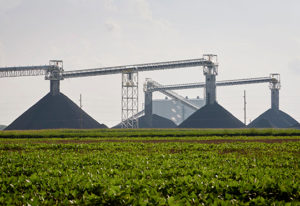
ARLP’s coal sales volumes increase in the Illinois Basin, which includes the Hamilton mine (above). (Photo: Alliance Resource Partners)
Alliance Resource Partners (ARLP) reported improved financial and operating performance for the quarter ended December 31, compared to the quarter ended September 30. Increased coal sales and oil and gas royalty revenues drove total consolidated revenues higher by 3.1% to $366.5 million compared to the sequential quarter. Higher revenues led to increased net income and EBITDA, which rose 28.8% to $35 million and 2.1% to $121.4 million, respectively, each compared to the sequential quarter.
Total revenues in the 2020 quarter were 19.2% lower compared to the quarter ended December 31, 2019, reflecting the impacts of reduced global energy demand resulting from the coronavirus (COVID-19) pandemic, according to the company. Lower revenues were offset by ARLP’s expense reduction initiatives implemented during 2020 in response to the pandemic, leading to a 35.6% increase in net income for the 2020 quarter compared to the 2019 quarter, according to Senior Vice President and CFO Brian Cantrell. EBITDA declined by 3.8% compared to the 2019 quarter due to lower oil and gas volumes and prices in the 2020 quarter.
ARLP’s performance and results for 2020 were also impacted by the effects of pandemic-related disruptions. Compared to the prior year, total revenues for 2020 decreased 32.3% to $1.33 billion.
“I am extremely proud of ARLP’s performance and accomplishments during the unprecedented turmoil we experienced in 2020,” Chairman, President and CEO Joseph W. Craft III said. “Amid the uncertainties created by the COVID-19 pandemic, ARLP’s operating teams performed heroically to ensure that our essential coal production remained available to our customers to protect the reliability of the life-sustaining, critical infrastructure of the electric grid supporting the communities we serve.”
The coal operations adjusted production in response to circumstances while the company said it implemented safety and health protocols to mitigate the impact of the virus.
“Despite the disruptions encountered during the year, through their decisive actions, our coal mining operations delivered the best safety results in ARLP’s history,” Craft said.
Looking forward, Craft said the company sees a bright future. “We’re in the energy business and we still believe strongly in coal, oil and gas,” he added.
He said it is unrealistic to think the U.S. would be fossil neutral by 2035. This will not happen overnight and is more “sound bites” than a vision of reaching that goal, he added.
He added that solar and wind only accounted for 3% of power generation in 2019.
Lower revenues and a non-cash goodwill impairment charge of $132 million, partially offset by lower operating expenses, resulted in a net loss of $129.2 million, according to the company. This compared to net income of $399.4 million for 2019, which included a non-cash net gain of $170 million related to the AllDale Acquisition. Adjusted net income and adjusted EBITDA for 2020 decreased to $27.8 million and $386.7 million, respectively, compared to $244.6 million and $599 million, respectively, for 2019.
During 2020, ARLP reduced capital expenditures; reduced operating expenses by 27.2%; reduced G&A expense by 18.1%; reduced total debt and finance lease obligations by 24.9%; reduced working capital by 23%; generated $279.5 million of free cash flow, an increase of 33.7%; and increased liquidity by 80.7% or $219.9 million.
ARLP’s coal sales volumes increased in both the Illinois Basin and Appalachian regions compared to the sequential quarter, leading total coal sales volumes in the 2020 quarter higher by 4.8% to 8.1 million tons. Illinois Basin coal sales volumes increased 5.2% on higher volumes at Hamilton and Warrior mines compared to the sequential quarter. In Appalachia, coal sales volumes increased 4.1% compared to the sequential quarter primarily due to higher sales from the MC Mining operation, which completed development of its new mine midway through the sequential quarter. Compared to the 2019 quarter, total coal sales volumes decreased 14.4% in the 2020 quarter primarily due to the impacts of the COVID-19 pandemic and reduced export shipments.
ARLP’s said its focus on reducing coal inventories and matching production to meet customer requirements resulted in total coal inventory falling to 600,000 tons at the end of the 2020 quarter, compared to 1.8 million tons and 1.2 million tons at the end of the 2019 and sequential quarters, respectively.
Total coal sales price per ton in the 2020 quarter fell 1.8% compared to the sequential quarter due to a 3.5% reduction in Appalachia as a result of lower price realizations at the Tunnel Ridge operation. In the Illinois Basin, coal sales price per ton in the 2020 quarter increased by 3.8% compared to the 2019 quarter due to improved price realizations at the Hamilton mine. In Appalachia, price realizations decreased by 8.4% compared to the 2019 quarter primarily due to weak market conditions and the absence of high-priced metallurgical sales volumes in the 2020 quarter.
“Entering 2021, we are encouraged by hopes for gradually improving economic recovery as the rollout of vaccines continues,” Craft said. “Increased economic activity in the U.S. is expected to result in improved energy demand and both our coal and minerals segments should benefit if this occurs. Increased power generation and a favorable natural gas price curve has coal consumption poised for a potential rebound.”
The company booked commitments for the delivery of approximately 9.9 million tons through 2025.
ARLP currently has contract commitments for approximately 24.1 million tons in 2021 and is targeting total coal sales volumes this year approximately 10% above 2020 levels.

